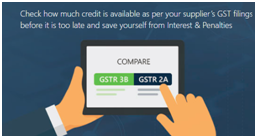We have all witnessed the first Financial Year in the GST regime and it has been quite a learning experience for professionals and businesses. It has been a roller coaster ride with its ups and downs and relaxations were provided by the govt from time to time to ease the burden on taxpayers. The GST era started with filing of 3 returns every month with extensive reconciliation of Input Tax Credit with your supplier's records. However, this was soon done away with due to the extra compliance burden it had on businesses and the technical glitches in the system.
Our GST Centre of Excellence at H&R Block is always striving towards finding the best solutions for our clients. In order to do this, we keep track of all the regulatory change, do our research and data analysis throughout the year. As the reconciliation process has been postponed by the government, most organizations have stopped doing reconciliation with their vendors' data. It might sound quite logical at first but this has many serious downsides, which could impact your input tax credit, compliance violations, and overall efficiency of doing business with certain vendors.
We strongly believe that every business should check their GSTR 2A on a regular basis and ensure that their suppliers are filing their GST returns and passing on the credit that you should get.
Know if your vendors have given you the input tax credit that you deserve
Top 5 reasons why you need to reconcile your books with supplier's filing:
1. Missing of input tax credits - We have observed that many organizations are missing to account for countless invoices they receive. This means loss of input tax credits leading to paying more tax than necessary. Reconciliation will ensure that you get all the required input tax credits and save a huge amount of taxes in the process.
2. Audit Process and internal financial control - Even though reconciliation is not mandatory anymore, the infrastructure to do so is still available. This means auditors will be able to get this data easily and logically, they will be checking your inward supply data against the 2A form. In case of mismatches, you'll have to do reconciliation for the entire year/quarter at once. So, it is advisable to do so incrementally every month and have reconciled records readily available for audits.
3. Tax department notice - Mismatches between your filings and your vendors' filings could potentially trigger a notice from the government. This could have significant financial impact as the penalties are usually quite high. Performing reconciliation every month would ensure your vendors' are also filing their returns with the same data as you expect them to use. In doing so, you can avoid any potential notices from the government. due to the mismatches.
4. Vendor Rating - Performing reconciliation on a regular basis would give you data points to determine the list of vendors which are doing the right thing and which ones are not following the right process, requiring you to follow up in solving the mismatches. This would eventually bring efficiency to your process through rating of those vendors.
5. Make corrections to your books of accounts - The filing of annual returns and audit will require matching of the amounts, as per the GST returns and the books of accounts. This makes it necessary to reconcile both these records and make the necessary rectifications in the books of accounts. This will certainly save you from interest and penalties which may be levied later, if it's too late.
In conclusion, we believe the reconciliation process even though, suspended by the government, it is necessary for businesses to continue this process to avoid future pain points caused by any mismatches.
The infrastructure created by the government. to perform reconciliation is available and we at H&R Block have built highly sophisticated, automated solutions and designed customized services to ensure you reap the benefits of this reconciliation process.
Compare your 3B with 2A right now to verify your tax credit
This tool is specially designed for businesses to help them to reconcile between tax credits they have claimed and the ones shown by their vendors.
The author of this article is a member of ICAI and has been working with H&R Block as a GST Expert. She specializes in matters of Indian GST and development of various applications at the organization. Her job involves helping people understand GST in the most simplified ways and helping with compliance of GST Laws.










 CAclubindia
CAclubindia

